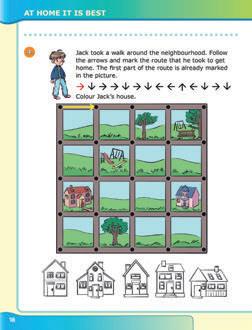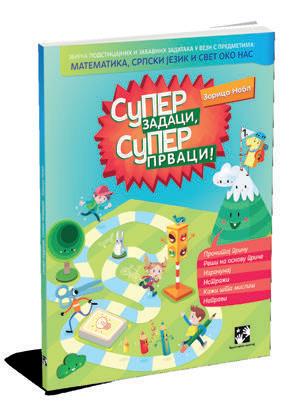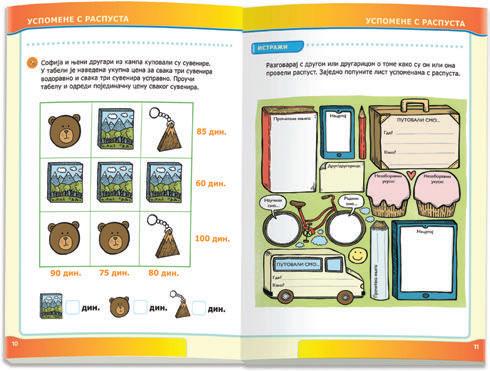4 minute read
SUPER CREATIVE THINKING ACTIVITIES 1
Next Article
21x28
This is a new activity series for school children. Each title consists of numerous tasks grouped by the theme which allows practicing the school curriculum in a fun way. Many creative activities are included in each theme: reading a story, solving many different tasks, calculating, exploring, giving an opinion, creating something, etc. The tasks are designed to be done individually, but a child can always ask for help (especially a 1st grader). Spontaneously, these tasks help kids obtain the soft skills they need for everyday life.





Author: Tomislav Senćanski 16x23cm, 240pp, full colour, hardcover
The bind-up version is a selection of 240 experiments in one book and it was created as a result of the 20 year-long presence of these titles in Serbia and in a dozen other countries around the world.

Patterns formed by sound
This experiment will allow you to do something very unusual: to give sound shape.
Necessary materials: an empty tin can, translucent tracing paper, some sand, a funnel, a rubber band, a flute
How the experiment is performed
1. Make an opening on the side of the can to fit the funnel tube.
2. Stretch the tracing paper over the open end and fix with the rubber band tightly.
3. Spread a little sand or other powder on the paper surface.
4. Insert the funnel into the opening as shown.
5. Play a tune into the funnel's opening.
What will happen?
The sand will begin oscillating on the paper and a regularly-shaped pattern will emerge.
Why?
The vibrations of the air inside the can caused by the flute are conveyed to the paper. But not all parts of its surface oscillate equally, so more sand is forced away from some areas than from others. In this way regular patterns are formed.
Additional idea
1. Repeat the experiment with another instrument and you will get a different pattern.
2. Fixing a plate of metal or glass on a standard as shown and spreading sand on it, pull a violin bow across its edge. This will also result in a pretty pattern.
Pictures formed by sound
If you want to see a picture of your voice, try the following experiment.
Necessary materials: a balloon, scissors, a short cardboard tube, a rubber band, some metal foil, a flashlight, glue
How the experiment is performed cyan magenta yellow black strana 45
1. Stretch a piece of the balloon rubber tightly across one end of the tube and fix with the rubber band.
2. Stick a small piece of foil on the balloon rubber.
3. Switch on the flashlight, and position it as shown, so that it is pointing at the metal foil at an angle enabling you to see a spot of light reflected on a wall or a piece of paper.
4. Speak into the open end of the tube, changing the pitch and loudness of your voice.
What will happen?
Dashes and wavy lines will appear on the spot of light.
Why?
The oscillations of your voice make the air in the tube vibrate. This forces the balloon, foil and therefore also the reflected light to oscillate. You will be able to see this in the form of short lines and wavy lines in the spot of light.
Rights
F u n n e l a n d F l aMe
When exposed to wind, the flame of candle becomes restless and bends in all directions. Do an experiment and see what it is that makes a flame bend.
What is going to happen?
When the air goes through the narrow part of the funnel, the flame bends away from the funnel. When the air comes out of the wide part of the funnel, the flame bends towards the funnel.
The reason why: separate and go different ways, making the flame move in the same direction as the air currents. When the air comes out of the wider part of the funnel, the air currents separate while still inside the funnel. The currents hit the walls of the funnel, change the direction and whirl, which is why the air reaches the flame from behind the candle and bends it towards the inside of the wider part of the funnel.
2.
Chara C teristi C s of Physi C al Bodies
F o l d i n G a P i e c e o F P a P e r
A piece of paper is easily folded. Try and see how many times you can fold it. Then try the same thing with pieces of paper of different sizes.
Materials required: pieces of paper of different sizes
1. Fold every piece of paper as many times as you can.
2. Make a note of the number of times you managed to fold each piece.
What is going to happen?
You won’t be able to fold any of the pieces of paper more than seven times.
The reason why:
Pieces of paper become multilayered by folding. When a piece of paper is folded several times, the number of layers is so big that it cannot be folded any more. Even very thin paper is very difficult to fold after the number of layers reaches more than one hundred, which happens after paper is folded seven times.
9
Simple Science Experiments series is one of our bestselling foreign rights titles. The series has been published in more than 10 countries and it has been on the Serbian market for almost 15 years, and its popularity has not diminished. These experiments can be the first steps towards science for every schoolchild. In performing them, children can learn important things about the basic laws of physics and chemistry. Some of the experiments are simple, some are more complex but all of them can be performed at home without any harm and with elements and materials found in every household. Scientific terms are simply explained through models, analogies and animations.
16x23 cm, 72 pp, full colour, paperback
SIMPLE SCIENCE EXPERIMENTS 1, 2, 3
Illustrator: Miroljub Milutinović Brada
Illustrator: Miroljub Milutinović Brada Group of illustrators
& 4
Illustrator: Nemanja Ristić





